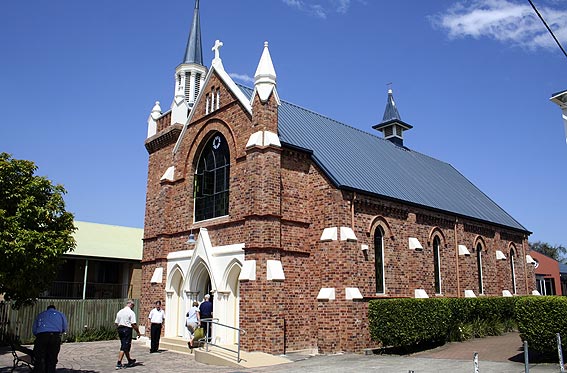
Nazareth Lutheran Church, Woolloongabba,
restored after the fire of April 2000
[Photograph by Trevor Bunning (May 2012)]

Nazareth Lutheran Church, Woolloongabba,
restored after the fire of April 2000
[Photograph by Trevor Bunning (May 2012)]
Historical and Technical Documentation by Geoffrey Cox
© OHTA 2007, 2014 (last updated October 2014)
Land was granted in Cordelia Street, South Brisbane, in 1857 for the purposes of the German Lutheran Church, and the congregation was established there from 1861 onwards. They soon outgrew the site, however, and following the 1893 floods a fine new brick church was dedicated on the present site in Woolloongabba on 10 May 1896.1 The architect was the Scottish-born Charles McLay (c.1860-1918), whose civic designs included the Customs House, Brisbane, and the Post Offices at Fortitude Valley and Bundaberg.2 During World War II the name of the church was changed from 'German Lutheran Church' to 'Nazareth Lutheran Church'.
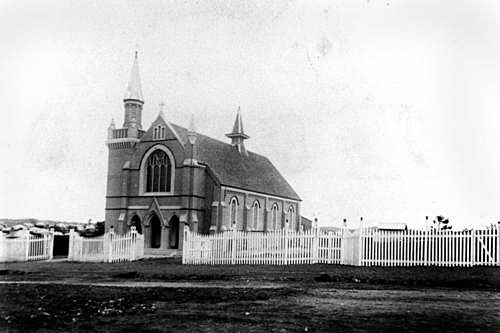
The German Lutheran Church, Woolloongabba, 1896
[Photograph: John Oxley Library, State Library of Queensland]
It is reported that a 'new organ' imported from Germany was installed in the church in 1912.3 This was clearly a reed organ, which remained in use at least until the early 1950s.4 A fire in April 2000 left only the brick walls of the 1896 building standing, but the decision was made to rebuild the church to the original plan.5
First Organ.
The first pipe organ in this church did not arrive until 1977. It had been built in 1926 for St Francis' Anglican Church, Nundah, by Whitehouse Bros of Brisbane, at a cost of £585, and was dedicated at Nundah on Sunday 26 September that year.6 This was at the same time as the firm's instrument for the Methodist Church at Bundaberg, and it was followed by their (slightly larger) instrument for Corpus Christi Catholic Church, Nundah, later that year.
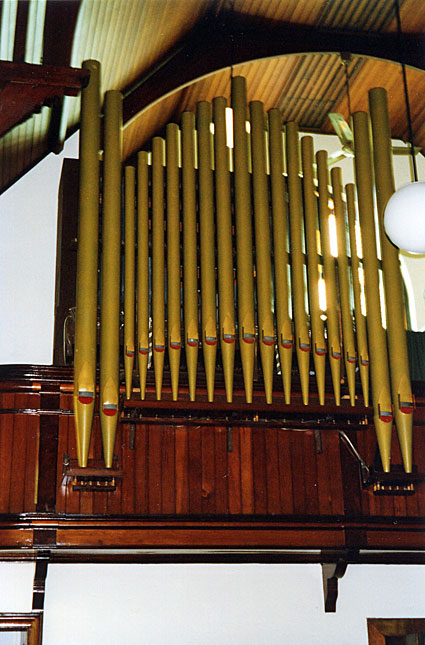
The 1926 Whitehouse organ from St Francis' Church, Nundah,
moved into the gallery at Woolloongabba in 1977
[Photograph by Howard Baker (1990s)]
The specification of the organ was as follows:
| GREAT Open Diapason Stopped Diapason Dulciana SWELL Violin Diapason Gedact Oboe PEDAL Bourdon COUPLERS Swell to Great Swell to Pedal Great to Pedal Swell Octave |
8 8 8 8 8 8 16 |
[operating through to Great] |
Tremulant [general]
Detached stop-key console
Radiating concave pedalboard
Hitchdown-lever swell pedal
Tubular-pneumatic action
Compass: 58/30.7
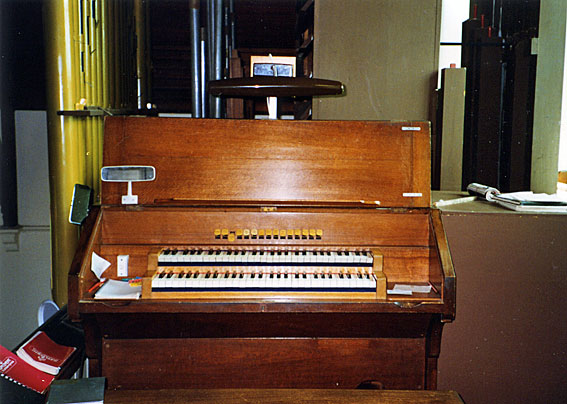
Console of the 1926 Whitehouse organ
[Photograph by Howard Baker (1990s)]
The organ was moved at St Francis' to the new church building there in 1959 by Charles Dirksen Organ Co. In 1977 it was moved by Whitehouse Bros to the Woolloongabba church,8 where it was installed in the gallery. At one of these latter stages, the hitch-down swell pedal was replaced by a balanced pedal, and three additional couplers (Swell Sub, Swell to Great Super, Swell to Great Sub) were provided.9 This instrument was completely destroyed in the fire of April 2000.
Present Organ.
A new instrument by W. J. Simon Pierce of Brisbane was ordered in 2001, to be installed in the gallery of the rebuilt church. The initial design comprised 12 stops. It was to follow many aspects of 'traditional' (i.e. late nineteenth-century English) practice: the Great pipework was to be unencased, and the Swell placed behind the Great; the pipework was to be of spotted metal and the bellows were to be double-rise. The nomenclature of the proposed specification nevertheless made obvious concessions to Lutheranism:
| GREAT Principal Hohlflute Octave Superoctave Mixture SWELL Gedact Rohrflute Nazard Gemshorn Krummhorn PEDAL Bourdon Flute COUPLERS Swell to Great Swell to Pedal Great to Pedal |
8 8 4 2 III 8 4 2-2/3 2 8 16 8 |
A A |
Tremulant [general]
Compass: 58/30
Mechanical action.10
Following Simon Pierce's study trip to the USA in 2001, many aspects of the design were modified: The number of stops was increased to 14, and the organ was to be entirely encased, with the Hauptwerk placed above the Brustwerk.
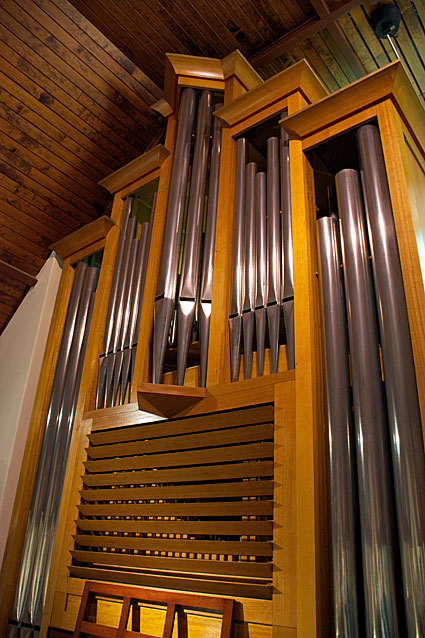
The 2005 organ by W.J. Simon Pierce
[Photograph by Rodney Ford (September 2014)]
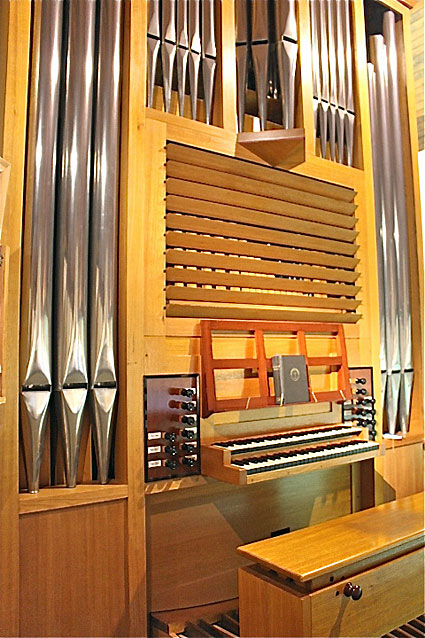
The 2005 organ by W.J. Simon Pierce
[Photograph by Trevor Bunning (September 2014)]
The specification underwent further minor changes,11 and was completed as follows:
| HAUPTWERK Prestant Hohl Flute Principal Quint Octave Mixture BRUSTWERK Gedact Rohr Flute Principal Quint Cornet Krummhorn PEDALE Subbaß Flute COUPLERS Bw-Hw Bw-Ped Hw-Ped |
8 8 4 3 2 III 8 4 2 1-1/3 II 8 16 8 |
[enclosed] [from Mid.C] A A |
Tremulant [General and/or Brustwerk]
Compass: 58/30
Balanced swell pedal
Radiating concave pedalboard [older]
Suspended mechanical action.12
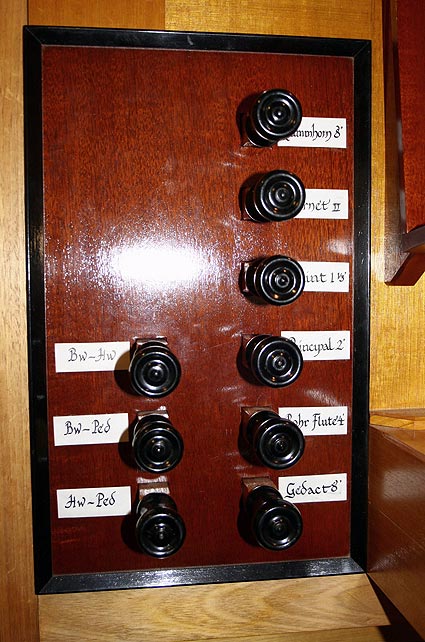
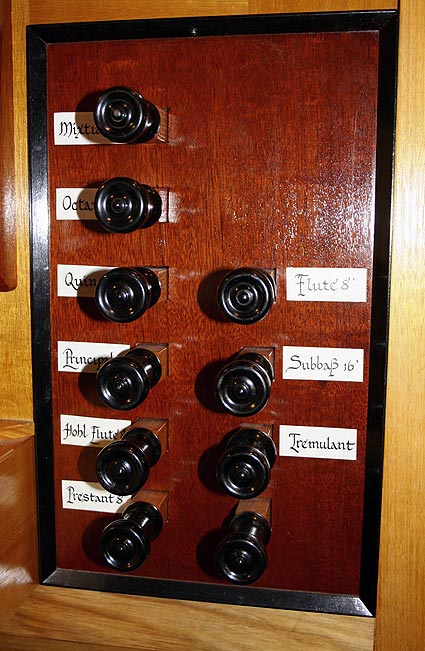
Stop jambs of the organ
[Photographs by Trevor Bunning (September 2007)]
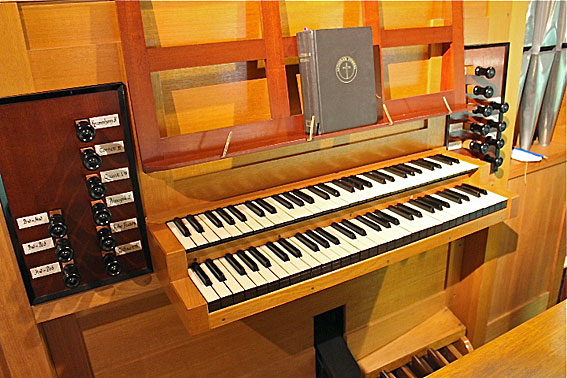
Console of the organ
[Photograph by Trevor Bunning (September 2014)]
This organ could justifiably be described as the first organ entirely built in Queensland! It was Simon Pierce's opus 4, and his largest instrument up to this time. All of the components, including the metal pipes, slider soundboards and rollerboards (of mahogany), were designed and constructed in Brisbane. Only the blower and brass fittings were imported. The casework is of Tasmanian oak with mahogany trim for the music desk and stop jambs. The keyboards use rosewood sharps and imported ivory-resin naturals.
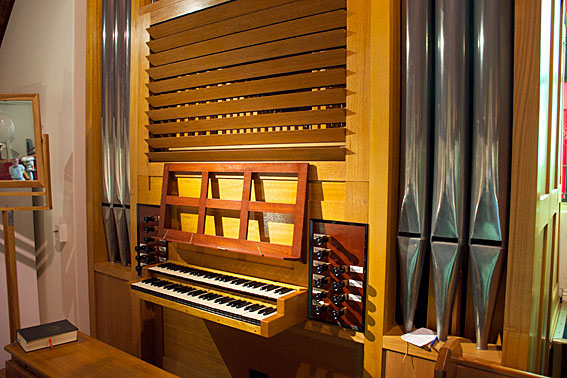
Console of the organ
[Photograph by Rodney Ford (October 2014)]
Most of the pipes are of metal, the only exceptions being the Gedact 8ft on the Brustwerk and the 42 pedal pipes for the Subbass 16ft and Flute 8ft. The pipe metal is of high-lead content (approximately 20% tin) and hammered. Wedge bellows were used to produce slightly flexible winding. A concession to modernity was made in the use of nylon bushing for the action parts, to accommodate the effects of the local humid climate. There are plans to add pipe shades and a Cymbelstern in the future.13
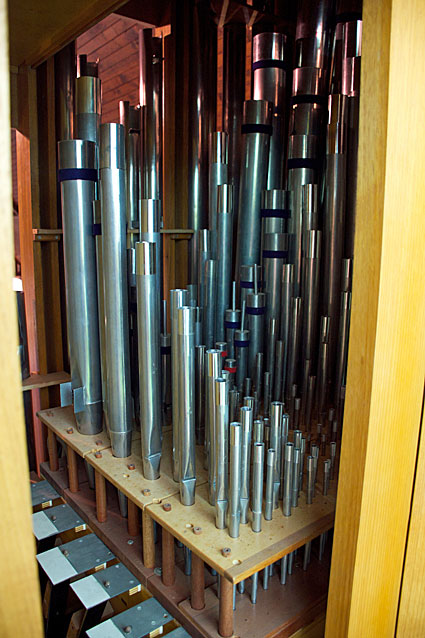
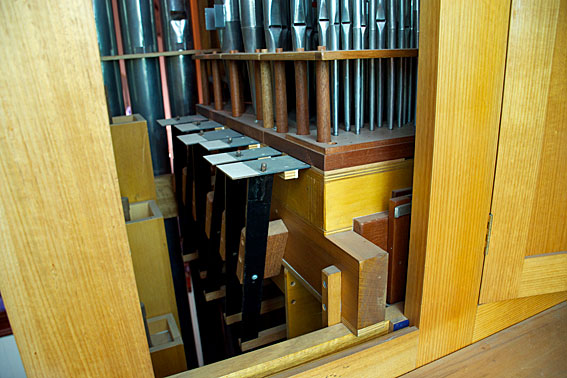
Stop action, slides and pipework of the Hauptwerk
[Photographs by Rodney Ford (September 2014)]
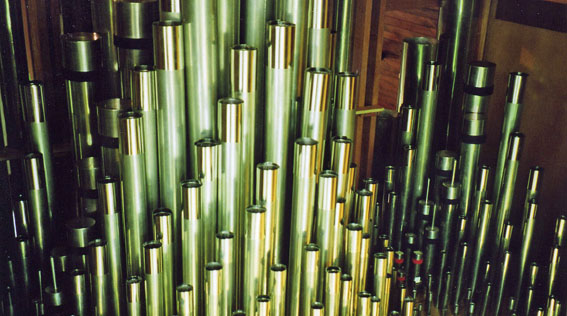
Pipework of the Hauptwerk, all constructed by W.J. Simon Pierce
[Photograph by Geoffrey Cox (September 2005)]
The construction of the instrument commenced in 2002, and it was completed in 2005. The organ was dedicated on 27 November 2005, and an opening recital was given by Christopher Wrench on 21 March 2006.14
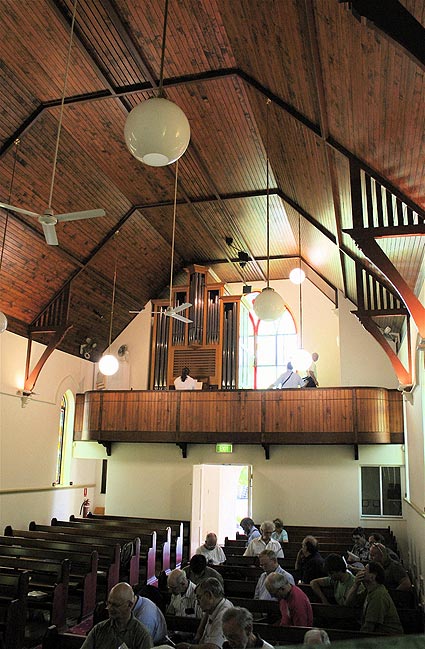
Interior of Nazareth Lutheran Church
[Photograph by Trevor Bunning (September 2007)]
__________________________________________________________________________
1 F. Otto Theile, One Hundred Years of the Lutheran Church in Queensland (Brisbane: UELCA, 1938), pp. 188-89.
2 Donald Watson & Judith McKay, Queensland Architects of the 19th Century: A Biographical Dictionary (Brisbane: Queensland Museum, 1994), pp. 119-20.
3 Theile, op. cit., p. 192.
4 Whitehouse Bros Ledger (1922-1940), pp. 257, 388, 416; Whitehouse Bros Ledger (1940-1954), p. 288.
5 The Organ Voice, vol. 26, no. 2 (June 2000), p. 23.
6 Whitehouse Bros Ledger (1922-1940), p. 145; The Brisbane Courier (25 September 1926), p. 14.
7 Collected Organ Specifications of Bernie Brohan (c.1952) & Notebooks of Mr. E. R. Salisbury.
8 Dates from records of St Francis' Anglican Church, Nundah, and Miss F. Reuther (organist at Woolloongabba).
9 Specification noted by Howard Baker, 1990s.
10 The Organ Voice, vol. 27, no. 2 (June 2001), p. 32; Simon Pierce, 'The New Pipe Organ for Nazareth Lutheran Church, Woolloongabba,' The Organ Voice, vol. 28, no. 4 (December 2002), pp. 38-41; reprinted with additions in Organ Australia, vol. 1, no. 3 (March 2006), pp. 22-25, and in OHTA News, vol. 30, no. 1 (April 2006), pp. 12-15.
11 Pierce, op. cit; see also back cover of The Organ Voice, vol. 28, no. 4 (December 2002), and The Organ Voice, vol. 31, no. 3 (September 2004), pp. 6-7.
12 Specification and details noted by G. Cox, September 2005 & September 2007.
13 Personal communication to G. Cox from Simon Pierce, July 2007.
14 W.J. Simon Pierce, Winter Newsletter 2006.